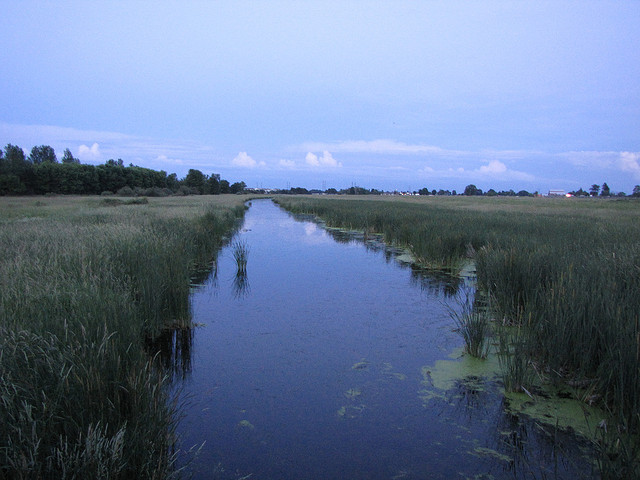rabble is expanding our Parliamentary Bureau and we need your help! Support us on Patreon today!
Canada is wet.
Indigenous peoples used lakes and rivers as their primary means of transportation. European newcomers quickly adapted, finding the canoe vastly superior to their old-world watercraft. Both pursued aquatic mammals — beaver, otter, mink and muskrat — fuelling the fur trade.
Abundant water was not always welcomed by later European arrivals. Much potential farmland was too wet to cultivate. Expanding settlements were boxed in by flood-prone and marshy areas. The solution was to dig ditches and move water off the landscape as quickly as possible, undoing the beavers’ work of damming streams and creating ponds.
Early Canadian laws and lawsuits often dealt with drainage. A History of Drainage Statutes in Ontario says that the 1835 Act to Regulate Line Fences and Watercourses was intended “to enable the owners or occupiers of such swampy or sunken land to cultivate or improve the same.” But an upstream landowner’s “reclaimed” property could flood his downstream neighbours.
Legal provisions added in 1859 allowed the majority of landowners in a given area to petition their township council to construct drainage works. Council would hire an engineer to prepare a report. If the council concluded that drainage would “greatly benefit” the township, it approved a bylaw financing construction of a municipal drain.
These provisions are still in effect. Ontario’s Drainage Act allows landowners to petition their council to drain wetlands, even those designated as provincially significant (for example, as habitat for endangered species). The majority of southern Ontario’s wetlands are now drained. Unless a municipality passes a new bylaw abandoning or modifying its drains, it must maintain them in perpetuity.
Some of Ontario’s best farmland — and highest-value real estate — occupies former wetlands. Municipal drains may indeed create a net local benefit. However, poorly planned drainage works may reduce the capacity of ecosystems to mitigate flooding and pollution and create serious risks to landowners.
Drainage projects involving channel alteration of large creeks and rivers are particularly risky. Consider the Carp and the Snake. Both of these eastern Ontario rivers once flowed sinuously through wetlands overlying poorly drained Leda clays that accumulated after glacial retreat in the former Champlain Sea.
The Carp River
In the early 1900s the upper portion of the Carp River was straightened and ditched by the Township of March. Wetlands were transformed into farmlands. These became housing developments in the 1960s and were incorporated into the City of Kanata in 1978 and then the City of Ottawa in 2001.
The broad, flat Carp valley is prone to flooding. Water does not readily penetrate Leda clay. In July 2009, a 100-millimetre, 24-hour rainstorm flooded about 1,500 homes. The City of Ottawa says, “In small headwater tributaries like the upper Carp River, flood-plains are often very wide, shallow and indistinct, so it may be necessary to modify the flood-plain to enable urban development to proceed in an efficient manner.”
For years now, the City of Ottawa has been considering a Carp River Restoration Plan that would allow further development in areas currently classified as flood-plains. But the costs of this plan — to be split 75:25 between developers and the City — keep going up, and environmental benefits (artificial ponds for fish and waterfowl habitat, a walking path along the river) — keep getting scaled back.
Interestingly, the City claims that the Carp River now “has no legal status as a municipal drain,” although the province’s Agricultural Information Atlas clearly shows it as such. The City adds that it is “unlikely” that the Carp River Restoration Plan could be carried out under the Drainage Act.
Apparently, at some point the Carp River ceased to be maintained as a municipal drain. It is now filled with sediment. Could this have contributed to recent flooding damage? Urban development in an area that was once drained, but where drains are not maintained, seems risky.
The Snake River
About 100 km west of Ottawa in rural Renfrew County, drainage of portions of the Snake River watershed also began in the early 1900s. A focus of this activity was the Upper Osceola Marsh, just upstream from the town of Osceola. Much of the Marsh remained intact until the Township of Bromley received a petition from landowners in the late 1960s. An engineer’s report recommended dynamiting a natural rock barrier and dredging a new, straight channel to replace the winding watercourse.
This was done — with municipal, county, provincial and federal subsidies. Farmers installed tile drains in their new fields. The Snake became an effective means of transporting large quantities of nutrients and sediments, discharging them into its receiving water body: Muskrat Lake, near Cobden.
Muskrat Lake is now the most polluted lake of its size in Ontario, with sky-high phosphorus levels. Blue-green algae bloom every summer. Aquatic weeds choke near-shore areas. Cottage owners are understandably upset.
Like the Carp, the Snake and its tributaries are filled with sediment. River and creek banks within the former Upper Osceola Marsh, covered only with annual grasses on unstable Leda clay, are highly vulnerable to erosion and slumping. Unlike the Carp, the municipal drains in the Snake watershed are maintained through periodic dredging. But in the absence of a comprehensive, watershed-scale restoration plan, this will only ensure that pollution problems persist in perpetuity.
It is pointless to blame past generations for pollution and flooding problems created by wetland drainage. They lacked our current scientific understanding of the value of wetlands for wildlife, carbon storage, groundwater recharge, and pollution and flood control. But we can do better. Watershed-scale planning, and selective wetland restoration, can be used to address problems where they occur.
Ole Hendrickson is a retired forest ecologist and a founding member of the Ottawa River Institute, a non-profit charitable organization based in the Ottawa Valley.
Photo: Wendel Fisher/flickr
rabble is expanding our Parliamentary Bureau and we need your help! Support us on Patreon today!




